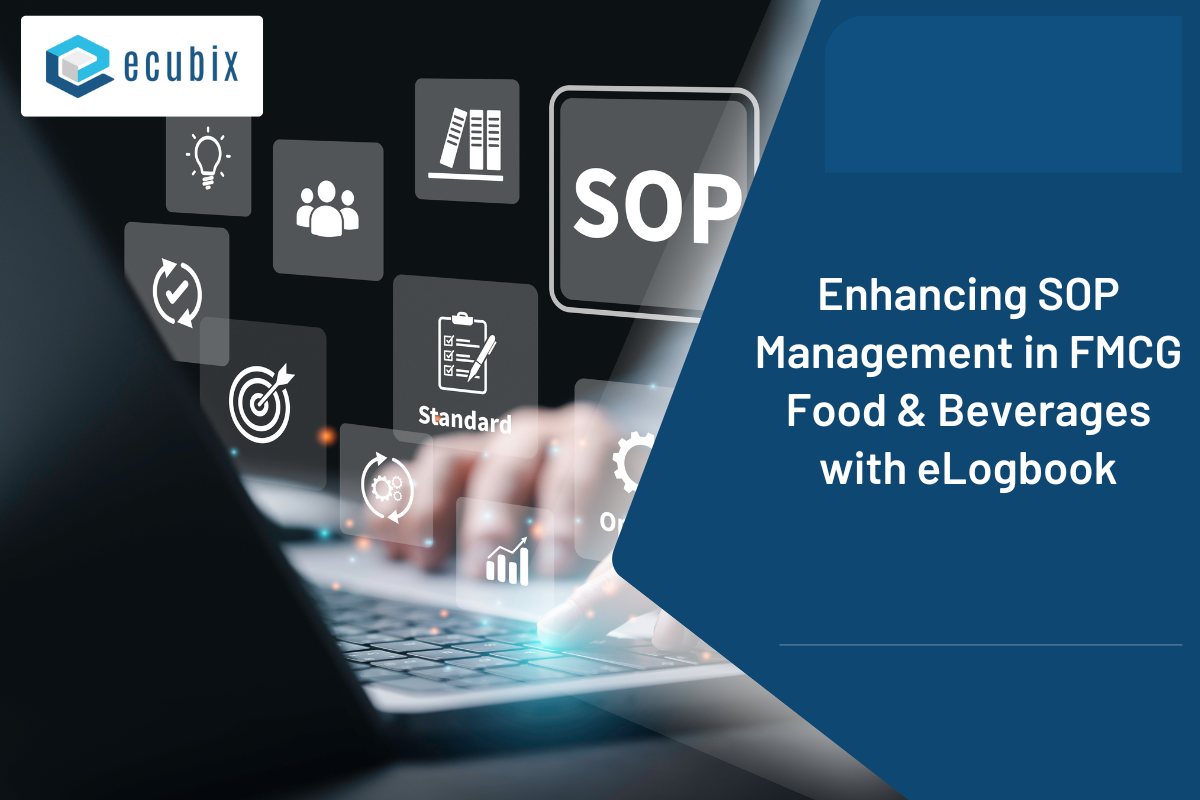
Table of Contents
Published on: October 16, 2024
In today’s competitive manufacturing landscape, businesses face increasing pressure to deliver high-quality products efficiently while meeting strict regulatory requirements. To meet these demands, manufacturers are adopting Electronic Batch Manufacturing Records to streamline their operations and ensure compliance.
eBMR systems can reduce batch record review times by up to 80% and improve production efficiency by 30%. Traditional paper-based systems are prone to human error with rates as high as 5-10%. In contrast, electronic batch manufacturing records implementation can reduce errors by up to 90%, ensuring higher data accuracy and consistent batch records across production processes. By capturing data in real-time, electronic batch manufacturing records allow production managers to monitor processes live and resolve issues quickly, leading to a 25% reduction in production downtime.
At the core of every manufacturing process lies routing the step-by-step sequence of operations and activities required to produce a product. Proper routing ensures that every task is performed in the correct order using the right resources. However, traditional paper-based records and manual processes often lead to delays, errors, and inefficiencies. Integrating electronic batch manufacturing records with routing enables manufacturers to improve production efficiency, reduce human error, and maintain regulatory compliance.
(1) Understanding Electronic Batch Manufacturing Record (eBMR)
An Electronic Batch Manufacturing Record is a digital version of traditional batch records used in manufacturing processes. It replaces manual paper-based systems, ensuring all batch-related data is captured, stored, and managed electronically. eBMR tracks and records each step involved in manufacturing, from raw material procurement to finished product release. Let’s identify batch manufacturing records process improvements using eBMR.
Digital vs. Traditional Batch Records:
Traditional records: Rely heavily on manual documentation, making them prone to errors, duplication, and loss of information.
eBMR: Automates data capture and provides real-time monitoring, improving both accuracy and speed while maintaining complete traceability of each production step.
Key Features and Functionalities of eBMR
- Automated data entry to eliminate manual processes.
- Workflow automation for approvals and escalations.
- Integrated dashboards to monitor batch progress in real-time.
- Electronic signatures and audit trails to ensure compliance with regulatory bodies.
- Alerts and notifications for deviations, ensuring proactive resolution.
Benefits of Electronic Batch Manufacturing Records
(A) Accuracy and Compliance: With automated data capture, eBMR ensures error-free records, essential for meeting FDA, GMP, ISO, and other industry standards. It minimizes the risk of non-compliance by providing a complete, traceable record for audits.
(B) Real-time Data Access: Supervisors and managers have instant access to batch information, facilitating faster decision-making and quicker troubleshooting.
(C) Enhanced Traceability: Every action is logged in real-time, ensuring that any deviations from the process can be identified, traced, and resolved efficiently.
(2) Routing in Manufacturing Processes

Routing refers to the sequence of operations or tasks required to manufacture a product. It ensures that each batch follows a pre-defined path, specifying the equipment, labour, and materials needed for every stage. Effective routing guarantees that resources are used optimally and production is completed within the required timeframe.
Steps Involved in Routing
(1) Planning:
- Design the sequence of operations to be performed.
- Assign resources such as machines, tools, and workers to each task.
- Create timelines for production.
(2) Execution:
- Follow the planned sequence to carry out tasks.
- Monitor equipment performance and material consumption.
(3) Monitoring and Control:
- Track progress in real-time.
- Adjust workflows to address unexpected issues and deviations.
Challenges in Traditional Routing Methods
- Manual Errors: Human involvement in routing often leads to delays, omissions, and inconsistencies.
- Data Silos: Lack of integration between systems can delay the flow of critical information.
- Limited Visibility: Supervisors may not have real-time insights into production progress, making it harder to address issues proactively.
(3) Integration of eBMR with Routing
How does eBMR support routing?
Integrating eBMR with routing systems bridges gaps between planning, execution, and monitoring. Electronic batch manufacturing records enhance the efficiency of manufacturing processes by ensuring that batch data flows seamlessly across operations.
- Streamlining Data Flow: eBMR automates the transfer of batch data between departments, reducing the time spent on manual documentation.
- Reducing Manual Errors: Operators follow standardized processes documented in the electronic batch manufacturing record, minimizing deviations and reducing the risk of costly errors.
- Ensuring Regulatory Compliance: Every step of the production process is automatically recorded, making it easier to meet audit and compliance requirements.
(4) Advantages of Using eBMR in Routing
Efficiency Improvements
- Time Savings: Automated workflows reduce the need for manual approvals and paperwork, accelerating production cycles.
- Cost Reduction: Fewer errors lead to reduced rework and material waste, lowering overall production costs.
Quality Control
- Consistency in Production: eBMR ensures that each batch follows a standard route, minimizing process deviations and ensuring uniform quality.
- Enhanced Product Quality: Real-time monitoring helps detect defects early, preventing defective products from reaching the market.
Regulatory Compliance
- Meeting Industry Standards: eBMR ensures compliance with regulations such as GMP (Good Manufacturing Practices) by maintaining detailed records for each batch.
- Simplifying Audits: Digital records streamline the audit process by making all relevant documents accessible in one system.
(5) Implementation Strategies to Implement eBMR in Routing
Successfully integrating Electronic Batch Manufacturing Records with routing processes requires careful planning and execution. Manufacturers need to address potential challenges, align the new system with existing workflows, and ensure smooth adoption across all levels. Below is a detailed description of the key strategies involved in implementing electronic batch manufacturing record for routing.

1. Assessment and Planning
The first step in implementing eBMR is to thoroughly evaluate the current state of the manufacturing process. This includes identifying pain points, defining clear goals, and determining how the new system can address specific bottlenecks. A solid plan lays the foundation for a smooth transition to electronic batch manufacturing records.
Identify Current Bottlenecks:
Companies need to conduct a thorough analysis of their existing routing methods to determine where inefficiencies exist. Common bottlenecks may include delayed approvals, manual data entry errors, or a lack of real-time monitoring. Identifying these issues ensures the new system addresses specific problem areas and eliminates process gaps.
Define Key Objectives for eBMR Implementation:
Setting clear and measurable objectives helps align the implementation with business goals. Objectives could include improving production speed, ensuring compliance, enhancing traceability, or reducing manual errors. These objectives serve as benchmarks for evaluating the success of the eBMR integration after rollout.
2. System Selection and Customization
Choosing the right eBMR platform is critical to ensure it fits seamlessly with the company’s existing IT infrastructure and meets operational needs. Customization ensures that the system aligns perfectly with specific production workflows to achieve maximum efficiency.
Choose an eBMR Platform That Integrates with ERP and MES Systems:
eBMR needs to function smoothly with other Enterprise Resource Planning (ERP) and Manufacturing Execution Systems (MES) to provide a unified solution. Seamless integration ensures smooth data flow across departments, avoids duplication of effort, and enables real-time monitoring. Companies must also evaluate whether the eBMR system can support compliance reporting and audit requirements. Here you can learn everything you need to know about eBMR solutions: in the detailed guide.
Customize the Solution to Align with Production Workflows:
Every manufacturer has unique processes that need to be considered during system implementation. Customizing the eBMR platform to reflect these workflows ensures that operators, supervisors, and managers can use it effectively. Customization can include defining specific routing steps, automating quality checks, or tailoring dashboards to meet the needs of different users.
3. Training and Change Management
Implementing a new eBMR system often requires significant changes to existing workflows. It’s essential to prepare employees through comprehensive training and manage resistance effectively to ensure a smooth transition.
Provide Training for Staff to Ensure Smooth Adoption:
Employees, including operators, supervisors, and managers, need to be trained on the new system to understand its functionality and operational benefits. Training should be hands-on and role-specific, ensuring that every user knows how to use the system to carry out their tasks. Regular workshops, refresher courses, and documentation help solidify knowledge and reduce dependency on external support.
Develop Change Management Strategies to Address Resistance:
Change often meets resistance, especially when employees are required to switch from manual processes to digital systems. To manage resistance, companies must engage with employees early in the process, communicate the advantages of the eBMR system, and offer support throughout the transition. Involving key stakeholders in decision-making and encouraging feedback can also promote smoother acceptance and foster a sense of ownership among staff.
These implementation strategies focused on careful assessment, system customization, and change management are crucial for companies adopting eBMR in routing. A well-executed implementation ensures improved efficiency, enhanced compliance, and lasting value from the new system.
Conclusion
The integration of eBMR with routing in manufacturing processes offers significant advantages, including improved efficiency, higher product quality, and enhanced compliance. eBMR ensures seamless data flow across production stages, reducing manual errors and enabling real-time monitoring. As technology evolves, future advancements in AI, IoT, and predictive analytics will further optimize manufacturing processes, setting new standards for the industry.
Manufacturers using eBMR report a 75% improvement in traceability, facilitating better batch management and audit readiness. eBMR helps companies meet stringent industry standards, reducing non-compliance incidents by 35%. The system also simplifies audit preparation, decreasing audit time by 50%, which is crucial for sectors like pharmaceuticals and chemicals where compliance is critical.

















